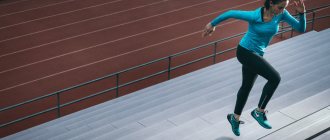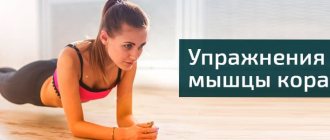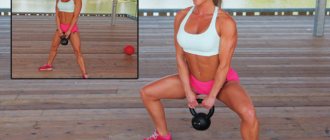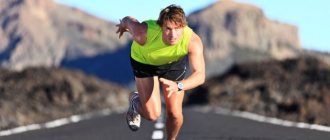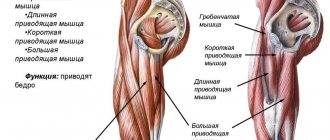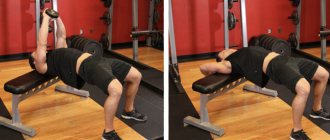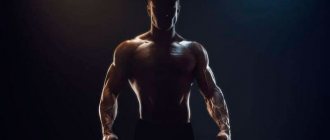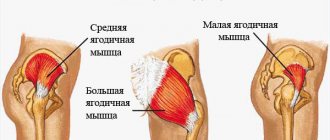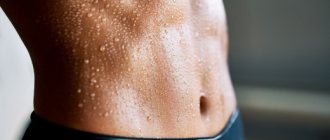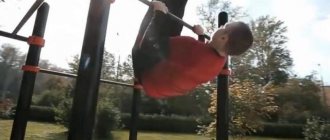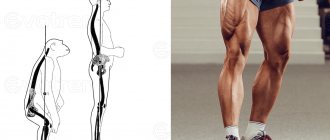The complex structure of the human muscular system has a number of functions, in particular motor functions. The muscles covering the skeleton perform various movements during life, including physical exercise. During the load process, one muscle cannot work alone; it is only part of the interaction of several muscle groups. Knowledge of the concepts: agonist, antagonist and synergist will allow you to understand the system of muscle communication during the loads performed and correctly draw up training programs.
What are agonist, antagonist and synergist muscles?
Agonists are skeletal muscles that perform the main movement in a specific exercise. That is, any muscle can be an agonist; a specific movement is necessary to determine it. For example, bending the arms at the elbow joint, in this case the agonist is the biceps brachii muscle.
Antagonists are muscles that oppose agonists. If the biceps acts as the agonist when bending the arm, then the triceps will act as the antagonist when extending the arm. But it can also be exactly the opposite. In extension movements, the triceps will be the agonist, and the biceps will be its antagonist. Muscles change roles only relative to movement.
Synergists - these muscles act as assistants to agonists during movement, taking part of the load onto themselves, or are stabilizers (fixators) of position. No muscle can contract in isolation; additional muscles, both external and internal - deep muscles, are always included to help.
Literature
- Ivanitsky M.F. Human anatomy: Textbook. for the institute of physics. cult. - M.: Physical culture and sport, 1985. - 544 p.
- Vanek Yu. Sports anatomy. – M.: Publishing Center Academy, 2008. 304 p.
- Person R.S. Antagonist muscles in human movements. - M.: Nauka, 1965, 114 p.
- Samsonova, A.V. Motor and sensory components of the biomechanical structure of physical exercises / A.V. Samsonova: abstract. dis...doct. ped. Sciences. - St. Petersburg - 1998. - 48 p.
- Samsonova, A.V. Biomechanics of muscles [Text]: educational manual / A.V. Samsonova E.N. Komissarova /Ed. A.V. Samsonova /St. Petersburg State. University of Physical Culture named after. P.F. Lesgafta.- St. Petersburg,: [b.n.], 2008.– 127 p.
- Samsonova A.V. Hypertrophy of human skeletal muscles: Textbook. - 5th ed. - St. Petersburg: Kinetics, 2022. – 159 p.
Sincerely, A.V. Samsonova
Examples of antagonist muscles
List of the main external groups of antagonists that work in strength exercises:
- Biceps brachii – triceps brachii.
- Elbow - shoulder.
- The quadriceps femoris muscle is the biceps femoris muscle.
- The pectoral muscles are the muscles of the back.
- The hip abductors are the adductor muscles.
- The flexor muscles of the torso are the extensor muscles of the back.
Also, the heads of one muscle can act as antagonists, for example, the anterior and posterior bundles of the deltoid muscle. The front bundle is activated when pushing the body in push-ups, bench presses, and brings the arms in front of you, while the rear bundle, on the contrary, abducts, is involved in rows, that is, it performs the opposite movement.
The main causes of bruxism in adults and jaw strain
- psycho-emotional reasons: nervous overstrain, prolonged stress, difficult experiences of situations,
- dental reasons: prolonged absence of teeth, malocclusion, diseases of the temporomandibular joint, complete or almost complete absence of teeth, inconvenient and poorly made crowns and dentures, fillings that are too high, injuries to the dental system,
- disorders of the musculoskeletal system: injuries and curvature of the spine, poor posture, asymmetry in the work of the core muscles,
- neurological causes: epilepsy, birth trauma, brain and central nervous system damage,
- other reasons: taking certain medications, smoking, abuse of caffeine-containing drinks.
“We always take a comprehensive approach to solving problems of hypertonicity of facial muscles. First of all, we look for causes from the maxillofacial apparatus - we carry out a full diagnosis and examination, evaluate the functioning of the masticatory muscles, identify the patient’s characteristic habits and collect a medical history. If necessary, we refer the patient to specialized specialists - a neurologist, psychotherapist, etc. It is very important to cure hypertonicity - at least so that the patient in the future can safely begin high-quality dental restoration: implantation, prosthetics or treatment.”
Aida Vladimirovna Jutova, implant surgeon, periodontist, work experience of more than 10 years make an appointment
Examples of synergist muscles
In each exercise, the target muscle has its own assistant or fixator. Examples:
- In an isolating single-joint curl exercise, the biceps synergist is the brachialis muscle, which flexes the forearm.
- When extending the arms, the triceps synergist is the elbow muscle, which extends the forearm.
- In the bench press, the target muscles are the pectoral muscles, while their synergists are the triceps. In this case, the muscles of the back of the shoulder take part of the load from the pectoral muscles and extend the arms at the shoulder and elbow joints.
- The biceps act as synergists for the back muscles; for example, during traction movements they take part of the load and bend the arms.
- In the case of such a multi-joint exercise as squats, for the hip extensor muscles - quadriceps, the synergist is the gluteal muscles, which are involved in the extension of the torso (in dynamics). But their synergists will also be the abdominal muscles and lumbar extensors, which perform a stabilizing function while in a static state and keep the spine in the correct position.
There is a solution for each case!
1 procedure
1 Botulax procedure Gentle and safe effect For mild cases of hypertonicity of the masticatory muscles RUB 15,000. 15,000 rub.
3 procedures
A course of 3 Botulax procedures Gentle and safe effects For moderate and severe stages of hypertonicity RUB 35,000. 35,000 rub.
Botulinum therapy can help if you have a habit of clenching your jaw tightly and grinding your teeth, you suffer from increased abrasion of enamel and destruction of crowns.
How best to train synergistic and antagonistic muscles
There are several options for performing programs based on the principles of muscle interaction, taking into account physical fitness.
Training for target groups (agonists)
For beginners, in order not to overload the muscles with more than one exercise, certain agonists are selected on the same day.
- For example, quadriceps, back, triceps, anterior and middle deltoids, rectus abdominis.
- Then in the next lesson their antagonists are trained: thigh biceps, pectoral biceps, shoulder biceps, spinal extensors, rear deltoids.
Thus, we get two training complexes. The first day can be performed a third time in a week, and day 2 can be moved to the next week.
As you get used to the loads, you need to make the task more difficult for the muscles, and perform more than one exercise for certain groups.
Split training muscle synergists
First, exercises are performed on large groups, then the work of the already tired small muscles of the synergists occurs. Three training days are enough to work out all the muscles in a week.
- Day 1. Legs with shoulders (4-6 exercises for quadriceps and hamstrings, 2-3 for deltoids).
- Day 2. Chest (3 exercises) – triceps (2 exercises).
- Day 3. Back (3 exercises) – biceps (2 exercises).
Antagonist training
The method is suitable for more prepared athletes , when a specific group and its opponent are trained in one training session. Each muscle group performs the same amount of exercise with the antagonist. This method is more complicated, since the antagonist of a large muscle is also a large group, for example, the chest - back.
While the agonist expends energy, the antagonist has less strength left, although his work requires no less effort. It is more difficult for beginners to perform such loads; in the first muscle group, energy reserves are depleted in sufficient quantities, and there is simply not enough strength to properly work out the second group. In this regard, trained athletes should begin loading according to this principle.
- Day 1. Leg muscles (quadriceps, hamstrings).
- Day 2. Shoulders (all beams, two exercises for each).
- Day 3. Back – chest (3 exercises for each group).
- Day 4. Biceps - triceps (3 exercises for each muscle).
Each training regimen is tolerated differently by everyone, so it should be selected individually, listening to the response of your own muscles.
Content
- 1 Pectoralis semispinalis muscle. Medial tract, transverse spinal system 1.1 Beginning
- 1.2 Attachment
- 1.3 Innervation
- 1.4 Functions
- 2.1 Beginning
- 3.1 Beginning
Disadvantages of treating bruxism with Botulax
It is important to choose an experienced, certified doctor who has trained and has official approval for botulinum toxin injection therapy - this is a rather complex procedure with its own subtleties. If the rules of storage, selection of dosage and administration technique are not followed, complications may occur. And if hematomas, bruises or slight swelling basically go away on their own, then difficulties with swallowing and chewing should be eliminated together with a doctor.
Our doctors have been trained and certified - treating hypertonicity with botulinum therapy in our clinic is completely safe
Story
The history often contains indications of deep pain in the groin or pain spreading along the anterior surface of the thigh. Pain may be initially triggered by the onset of activity, decreasing shortly thereafter. Symptoms may progress to constant pain during activity that improves only with rest, and finally to pain with both activity and rest. Diagnosis is usually delayed, and the average estimated time between initial symptoms and diagnosis is 32 to 41 months.
- Intermittent pain in the groin, usually described as a deep pain.
- Symptoms worsen with activity (especially kicking) and improve with rest. Other aggravating factors include tying shoelaces, standing up after sitting for a long time, and walking uphill.
- An audible clicking or pinching sensation in the hip or groin area.
- Radicular symptoms may be reported, extending along the front of the thigh to the knee.
- Psoas muscle dysfunction is usually associated with a variety of lumbosacral complaints, which may include low back pain, discomfort in the buttocks or thighs, and inability to stand completely upright.
Epidemiology
In general, pathological conditions of the groin, such as tendonitis, bursitis, snapping, and impingement, are considered the main cause of chronic groin pain in approximately 12-36% of athletes and in 25-30% of athletes with acute groin injury.
- It is most common in athletes such as football players, but can also occur in non-athletic populations.
- The most commonly reported incidence is in young adults (peak age group is in the 30s).
- Slightly more common in women.
Forecast
- Provided the underlying biomechanical deficiency is corrected, the overall prognosis is favorable.
- Identifying this deficiency early may play a role in preventing the development of chronic symptoms. However, as mentioned earlier, the diagnosis of PPM tendinopathy is made approximately two years after symptoms develop. In these cases, recovery may take longer.
- The patient should not return to sports until they have achieved a full and pain-free range of motion.
